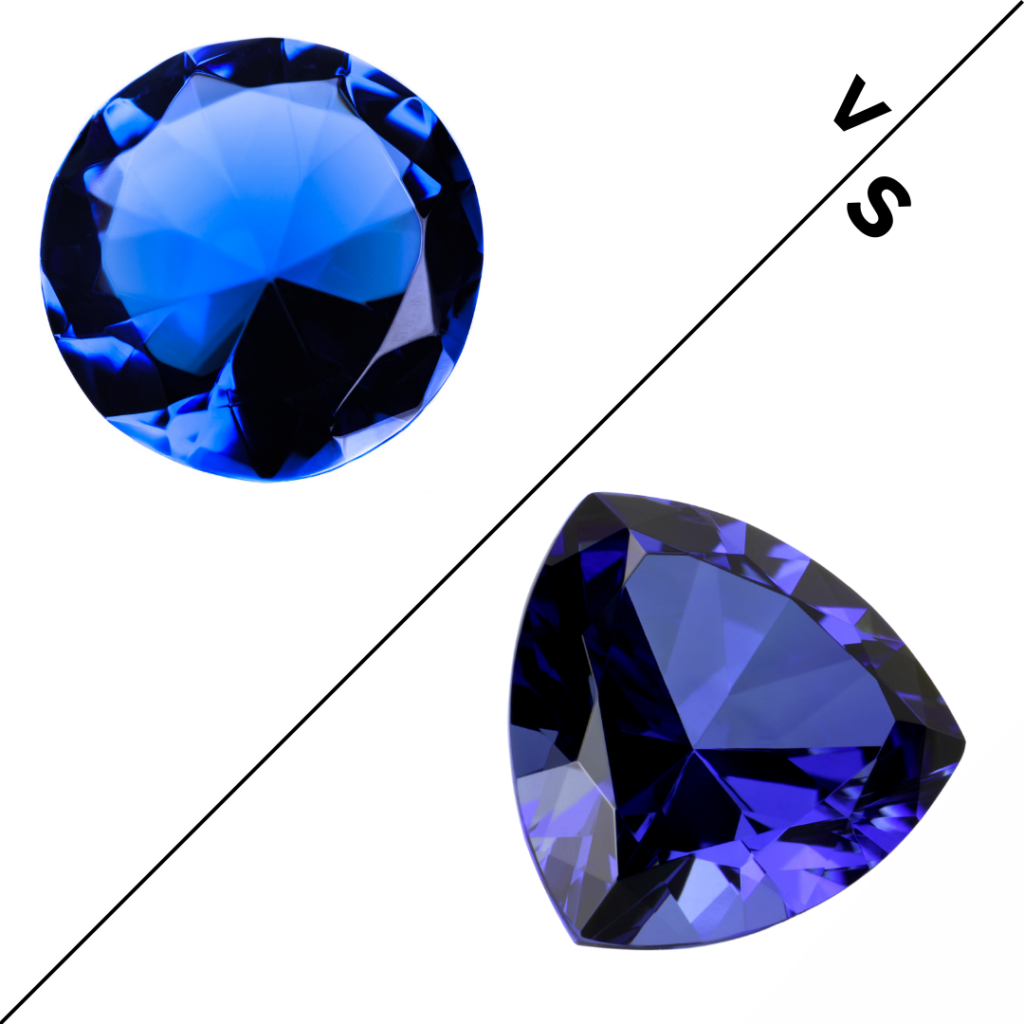What are the key differences between blue sapphire and tanzanite?
Sapphire v/s Tanzanite

Blue Sapphire vs Tanzanite: A Comparative Analysis
Gemstones have captivated humans for centuries, exuding their alluring colors and unique characteristics. Two striking blue gemstones, blue sapphire and tanzanite, have garnered significant attention in the jewellery industry. This blog will compare these gemstones based on clarity, durability, colour variation, rarity, and pricing.
5 Main differences between these amazing gemstones:
- Clarity:
Blue sapphires often exhibit excellent clarity, as their formation deep within the Earth’s crust allows for the slow growth of crystals and the development of fewer internal flaws. In contrast, tanzanites frequently contain inclusions, mainly due to their formation in a volcanic environment. These inclusions might reduce the overall clarity of tanzanite stones, making blue sapphires more desirable for those seeking flawless gemstones. - Durability:
Sapphires reign supreme in terms of durability, ranking a solid 9 on the Mohs scale. Their exceptional hardness makes them ideal for daily wear, ensuring minimal scratches or fractures. On the other hand, tanzanites rank significantly lower on the scale at 6.5-7. While still durable enough for regular wear, tanzanites require extra care and attention to prevent damage. Thus, blue sapphires offer a noteworthy advantage in terms of longevity and practicality. - Colour Variation:
Both blue sapphires and tanzanites exhibit mesmerizing blue hues, but their colour variation sets them apart. Blue sapphires present a wide spectrum of shades, ranging from deep royal blue to lighter cornflower blue. Consequently, individuals seeking a specific blue shade will find a greater array of options with blue sapphires. Conversely, tanzanites possess a more restricted colour range, typically showcasing a vibrant blue-violet shade. This strikingly singular hue creates a distinct appeal for those desiring a unique gemstone choice. - Rarity:
Tanzanites hold a distinct advantage in rarity, serving as a significant driver of their desirability. This gemstone was discovered relatively recently in 1967 in Tanzania and has a limited supply. Moreover, tanzanite mining occurs in a single location worldwide. Due to these factors, tanzanite is considered a rare gemstone and may fetch higher prices in the market. Blue sapphires, while not as scarce as tanzanites, are also highly valued but are comparatively more abundant, originating from various locations such as Sri Lanka, Australia, and Madagascar. - Pricing:
The cost of blue sapphires and tanzanites ranges considerably. Blue sapphires tend to command higher prices, especially for stones with superior clarity, larger size, and a more intense blue colour. The price of blue sapphires might increase further if they bear a renowned origin, such as Kashmir or Burma. Although relatively rare, Tanzanites are usually more affordable due to a combination of factors, including availability in smaller sizes and lower demand than sapphires. This affordability makes tanzanite an attractive alternative for individuals seeking an exquisite blue gemstone without breaking the bank.
The comparison between sapphire and tanzanite reveals several key differences and similarities. Blue sapphires excel in terms of clarity, durability, and color variation, making them popular choices for discerning buyers seeking a timeless statement piece. On the other hand, tanzanites possess rarity, boasting a distinct hue that caters to individuals who crave exclusivity. While sapphires tend to be more expensive, tanzanites provide an affordable option for those searching for a stunning alternative. Ultimately, personal preference, budgetary considerations, and the significance of rarity will drive the choice between these two captivating blue gemstones.
Spiritual and mythological beliefs of blue sapphire and tanzanites.
Blue sapphire and tanzanite are two gemstones with rich spiritual and mythological significance. In various cultures and belief systems, these gems hold deep symbolism and have been associated with mystical properties.
Sapphire, known for its striking hue, has long been revered as a stone of wisdom and royalty. In ancient civilizations, it was believed to embody the celestial energies and was associated with the divine. In Hindu mythology, blue sapphire, also called Neelam, was considered the gemstone of Saturn, the planet of discipline and karma. Wearing this gemstone was believed to bring harmony to one’s life, enhance concentration, and protect against negative energies.
Similarly, with its mesmerizing blue-violet shade, tanzanite carries its own spiritual significance. This gemstone is said to stimulate intuition and spiritual growth. It is associated with the third eye chakra, symbolizing the awakening of one’s psychic abilities and inner vision. Tanzanite is believed to promote a deep sense of calmness, balance, and spiritual transformation.
Sapphire and tanzanite have been regarded as stones of spiritual protection, shielding the wearer from psychic attacks and negative influences. They are also considered to be talismans of truth and spiritual awakening, guiding individuals toward their life purpose and higher consciousness.
Both gemstones are believed to possess mystical properties that promote wisdom, intuition, and spiritual growth. Whether used as adornments or meditation tools, these gems continue to hold a special place in various cultures and belief systems.







